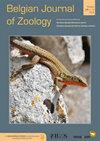蒙塔古鹞式马戏pygarus繁殖成功的长期变化
IF 1.1
4区 生物学
Q2 ZOOLOGY
引用次数: 5
摘要
在近20年的时间里,在波兰东部该物种自然繁殖栖息地不断变化的环境条件下,对蒙塔古鹞的离合器大小和繁殖成功进行了调查。在研究期间(1990-95年和2003-12年),在距离波兰-乌克兰边境不远的切姆附近的钙质泥炭沼泽上筑巢的种群中,繁殖对的数量有所下降。两个时期的育种参数也有统计学上的显著差异。在第一个时期,离合器的体积更大,因为单个卵子的尺寸更大;此外,孵化出的卵越多,孵化的成活率也越高。两个时期的一些栖息地条件不同,第二个时期巢穴附近的水位和植被高度较低。在两个研究期间,鹞的食物在小型哺乳动物和补偿项目的含量方面波动很大。在第二阶段,捕食者的压力明显增加。来自陆地捕食者的压力减少,而来自空中捕食者的压力增加。半殖民地的鸟群,鸟类积极保护它们的巢穴,生存率更高,远离泥炭沼泽边缘的巢穴也是如此。研究结果表明,繁殖数量的下降是由捕食增加引起的,而捕食又是波兰东部自然环境中栖息地变化的结果。本文章由计算机程序翻译,如有差异,请以英文原文为准。
Long-term changes of breeding success in Montagu’s Harrier Circus pygargus
Over a period of almost twenty years, clutch size and breeding success in the Montagu’s Harrier were investigated in the context of changing environmental conditions in the species’ natural breeding habitats in eastern Poland. During the study periods (1990-95 and 2003-12) a decline was noted in the number of breeding pairs in the population nesting on the calcareous peat bogs near Chełm, not far from the PolishUkrainian border. Statistically significant differences in breeding parameters between the two periods were also observed. In the first period clutch volumes were greater, as the dimensions of the individual eggs were larger; additionally, more eggs hatched and the hatchling survival rate was higher. Some habitat conditions were different in the two periods, with the water level and height of vegetation near the nests being lower in the second period. The harriers’ food in the two study periods fluctuated strongly with regard to the content of small mammals and compensatory items. In the second period a distinct increase in predator pressure was noted. Pressure from terrestrial predators diminished whereas that from aerial predators increased. Broods in semicolonies, where birds actively defended their nests, enjoyed a higher rate of survival, as did nests situated far in from the edge of peat bogs. The results suggest that the decline in breeding numbers was driven by increased predation, which was in turn a consequence of habitat changes in the natural environment of eastern Poland.
求助全文
通过发布文献求助,成功后即可免费获取论文全文。
去求助
来源期刊

Belgian Journal of Zoology
生物-动物学
CiteScore
1.90
自引率
0.00%
发文量
10
审稿时长
>12 weeks
期刊介绍:
The Belgian Journal of Zoology is an open access journal publishing high-quality research papers in English that are original, of broad interest and hypothesis-driven. Manuscripts on all aspects of zoology are considered, including anatomy, behaviour, developmental biology, ecology, evolution, genetics, genomics and physiology. Manuscripts on veterinary topics are outside of the journal’s scope. The Belgian Journal of Zoology also welcomes reviews, especially from complex or poorly understood research fields in zoology. The Belgian Journal of Zoology does no longer publish purely taxonomic papers. Surveys and reports on novel or invasive animal species for Belgium are considered only if sufficient new biological or biogeographic information is included.
 求助内容:
求助内容: 应助结果提醒方式:
应助结果提醒方式:


